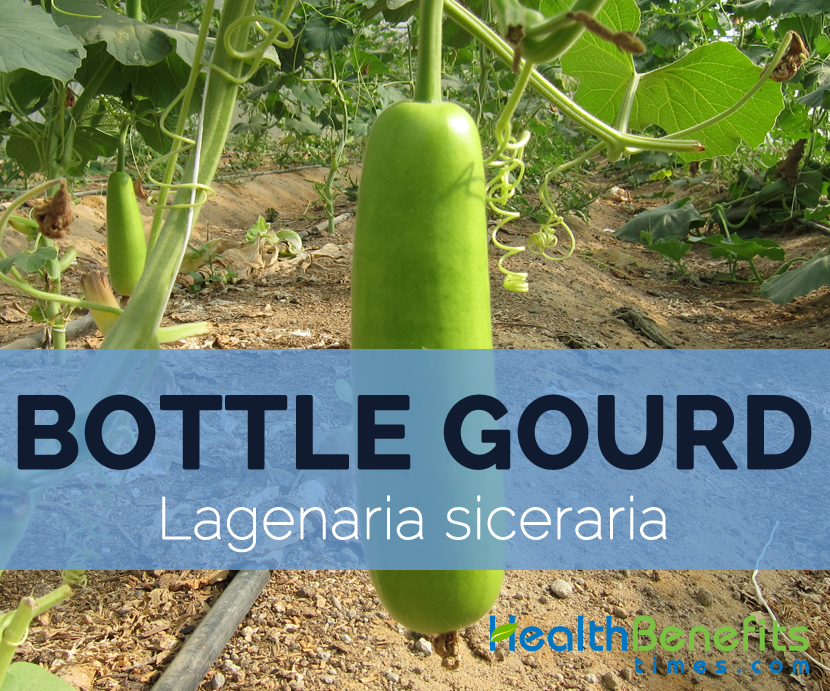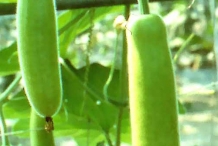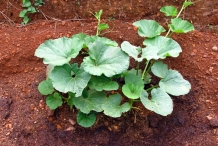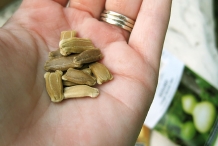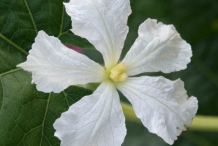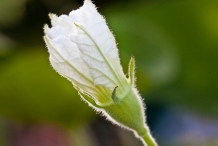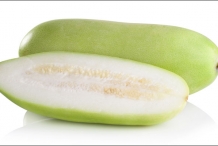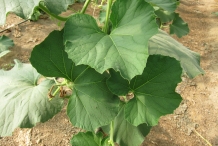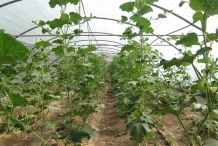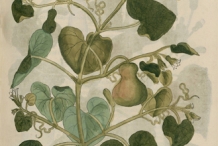| Bottle gourd Quick Facts |
| Name: |
Bottle gourd |
| Scientific Name: |
Lagenaria siceraria |
| Origin |
Tropical Africa |
| Colors |
Light-green |
| Shapes |
Oval, pear shaped or elongated; Length: 1 m |
| Flesh colors |
White |
| Taste |
Nutty |
| Calories |
16 Kcal./cup |
| Major nutrients |
Vitamin C (13.00%)
Zinc (7.36%)
Potassium (3.70%)
Vitamin B6 (3.54%)
Vitamin B5 (3.52%)
|
| Health benefits |
Skin health, Lowers stroke, Treats cancer, Prevents colds and flu, Hormonal balance |
Bottle gourd, Lagenaria siceraria, is a genus of tropical and subtropical vines in the Cucurbitaceae family. It is also called Calabash Gourd, Trumpet Gourd and Long Squash. The immature fruit of these species are consumed as vegetables. It is pear shaped with light green coloration. The immature fruit has white spongy flesh. The Bottle gourd may grow as 1 meter in length. Native to Tropical Africa, it is widely grown for the foods. The bottle gourd requires warm climate and well-drained soil to grow. The two varieties of Bottle gourd are: Pusa Summer Prolific Long and Arka Bahar.
Rounder varieties are called calabash gourds, which can grow in a variety of shapes: huge and rounded, small and bottle shaped, or slim and serpentine. L. siceraria is an important member of the Cucurbitaceae family. It is a warm- season fruit or vegetable and is cultivated throughout Pakistan and India. L. siceraria is an excellent fruit in nature, consisting of all the essential constituents that are necessary for the normal and good health of human beings. There are two varieties of this vegetable, namely sweet variety and bitter variety. Both varieties belong to the Lagenaria genus. Generally, the sweet variety is used for vegetable purposes, while the wild bitter variety is preferably used in medicines.
Nowadays, bottle gourds are grown by direct sowing of seeds or transplanting 15- to 20-day-old seedlings. The plant prefers well-drained, moist, rich soil. It requires plenty of moisture in the growing season and a warm sunny position sheltered from the wind. In rural areas, many houses with thatched roofs are found covered with the gourd vines. Bottle gourds grow very rapidly and their stems can reach a length of 9 m in the summer, so they need a solid support to climb via pole or trellis. The plant produces white flowers. The male flowers have long peduncles and the females have short peduncles with an ovary that is the shape of the fruit. Female flowers have a thick style with three bilobed stigmata.
History
Bottle gourds were the plants which were used by humans as long as 8,000 to 10,000 years ago in the form of musical instruments, containers and fishing floats. Firstly, it was cultivated in Africa, then Asia and finally reached to America.
Plant
The Bottle gourd plant is an annual, vigorous, monoecious, climbing herb often cultivated in warm climates. It grows as a vine with alternate, broad, deep green leaves that are 400 mm long and 400 mm broad. The stem is often thick, angular, ribbed, brittle and hairy which is about 5 m long. The plant yields flower during summer which is monoecious, white, obovate; 15 cm across and 10–15 mm long. The pear shaped smooth light green fruit has white and spongy flesh. The fruit is 1 meter long. It contains brownish seeds which are oblong, and 2 cm long.
Nutritional Value
The serving size of 116 grams contains 16 calories and provides 13% of Vitamin C and 7.36% of zinc. The same amount of Bottle gourd provides 174 mg of Potassium, 13 mg of Magnesium, 15 mg of Phosphorus and 2 mg of Sodium. Bottle gourd possess various amounts of nutrients, minerals, vitamins, lipids and amino acids.
Phytochemical Properties
- Fruits
Phytochemicals extracted from the fruit of Lagenaria siceraria revealed that it contains 0.2% of protein, 0.1% of fat, 2.9% of carbohydrates, 96.3% of moisture, 0.5% of mineral matter, <0.01% of phosphorus, and 0.02% of calcium. Earlier studies reported that a number of mineral elements are present: iron 0.7 mg, sodium 11.0 mg, potassium 86.0 mg, and iodine 0.45 μg per 100 g. Fructose and glucose have also been found. The amino acid composition of the fruit is phenylalanine 0.9 mg, leucine 0.8 mg, valine 0.3 mg, tyrosine 0.4 mg, alanine 0.5 mg, glutamic acid 0.3 mg, serine 0.6 mg, aspar tic acid 1.9 mg, cystine 0.6 mg, cysteine 0.3 mg, arginine 0.4 mg, proline 0.3 mg, and threonine 0.2 mg per gram of the fruit. Bitter fruits also contain bitter principles in the form of aglycones. These principles include cucurbitacins B, D, and E.
- Seeds
Reports show that saponins are present in the seeds. The analysis of the seed kernels showed the following values: 30.72% of protein, 8.3% of carbohydrates, 2.47% of mois ture, 52.54% of oil, 4.43% of ash, 1.58% of fiber, 2.46% of P2O3, and 0.11% of CaO. The color of the oil obtained from the seed kernels is clear and pale yellow in appearance. Ripe seed kernels gave 45% of the oil. This oil has the following features: iodine value 126.6, saponification equivalent 301.7, 0.55% of free fatty acids, and 0.68% of unsaponified matter. Free fatty acid components were found to be 18.3% of oleic, 64.1% of linoleic, and 17.9% of saturated fatty acids (CSIR, 2004). Reports show that the seeds also contain lagenin.
- Leaves
Leaves contain cucurbitacin B, carbohydrates, phytosterols, saponins, phenolic compounds, tannins, proteins, amino acids, and flavonoids.
- Roots
The roots contain cucurbitacins B, D, and E and the triterpene bryonolic acid.
Health Benefits of Bottle gourd
Bottle gourd possess high amount of fiber which prevents the constipation, piles and flatulence. The cholesterol and fat in Bottle gourd is very low. The richness in Vitamin B and C assists in anti-oxidant properties. It consists of 92% water. The juiced or cooked Bottle gourd possesses anti-bilious and sedative properties.
- Acts as an antioxidant
It is a well-established fact that reactive oxygen species (ROS) are implicated in more than 100 diseases, such as heart disease, stroke, arteriosclerosis, malaria, acquired immunodeficiency syndrome (AIDS), diabetes, and can cer. It is, therefore, important for researchers to seek natural sources of antioxidant. Such effects are generally credited to antioxidant components including plant phenolics such as phenylpropanoids and flavonoids Gallic acid was used as a reference antioxidant compound. The samples showed appreciably high DPPH radical scavenging effect at all concentrations. However, the ethyl acetate extract of fresh fruits was more active than the rest of the samples. The ethanol extract of fruits of L. siceraria was also evaluated for antioxidant activity. The results obtained in this study also indicated that the fruits are a potential source of natural antioxidants.
- Antihyperglycemic activity
The antihyperglycemic activity of methanol extract of L. siceraria was evaluated in hyperglycemic rats. Extract was given at doses of 200 and 400 mg/kg per os (p.o.) to streptozotocin induced hyperglycemic rats for a period of 14 days. Fasting blood glucose (FBG) was measured on days 0, 4, 8, and 15 after treatment. There occurred significant reduction (P < 0.001) in FBG levels; other biochemical tests (SGPT, SGOT, ALP, total cholesterol, triglycerides), antioxidant assay (lipid peroxide, catalase, and glutathione), and histological study of the liver, the liver, kidney, and pancreas tissue, supported the conclusion. The research showed the potent antihyperglycemic activity of L. siceraria, which is probably attributable to its rich flavonoid content.
- Helpful for allergies
The anti-asthmatic and anti-allergic activity of the aqueous extract of leaf of L. siceraria (LSA) was evaluated in different animal models. The histamine and acetylcholine induced bronchoconstriction model in guinea pigs, the compound 48/80 induced mast cell degranulation model in rats, and the paw edema model in mice were used. The results of the study revealed a significant bronchodilator activity by LSA at doses of 150 and 300 mg/kg. Anti inflammatory activity was observed at doses of 50, 75, and 100 mg/kg (intraperitoneal injection) against compound 48/80 induced paw edema in rats. These results support the traditional claim of the drug as a treatment for asthmatic disorders. It was also reported that the triter pene bryonolic acid, an anti-allergic compound, was isolated from callus culture of the roots of L. siceraria.
- Acts as Antihyperlipidemic
Traditionally the fruit of L. siceraria had been used in the management of hyperlipidemia and atherosclerosis, as it had been thought to possess cardioprotective and cardio tonic potential. The effects of methanol extract of L. siceraria were investigated in experimentally induced hyperlipidemia in rats. Methanol extract of L. siceraria fruits (LSFE) at doses of 100, 200 and 300 mg/kg p.o. was given to the high fat diet induced hyperlipidemic rats for 1 month to evaluate its antihyperlipidemic potential. Oral administration of the extracts dose-dependently inhibited the total choles terol, triglycerides, and low-density lipoproteins level, and significantly increased the high-density lipoproteins level. The results of the study showed that the methanol extract from the fruits of L. siceraria has a definite antihyperlipi demic potential. In the study, petroleum ether, chloro form, alcoholic, and aqueous extracts of L. siceraria were evaluated for antihyperlipidemic activity. Out of the four different extracts, only the petroleum ether extract did not show antihyperlipidemic activity, while the other extracts showed good antihyperlipidemic activity.
- Cardiovascular health
L. siceraria fruit is traditionally used for its cardioprotective effect. The cardioprotective activity of L. siceraria fruit was investigated using a doxorubicin induced cardiotoxicity model of Wistar rats. Group I of the Wistar rats (250–300 g) was the control group, and it received 2% gum acacia; group II was the doxorubicin treated group, and it received doxo rubicin 10 mg/kg; and group III was the doxorubicin with L. siceraria treated group, and it received L. siceraria fruit powder 200 mg/kg for a period of 18 days. The results of the study showed that after administration of L. siceraria there was a significant decrease in QT (p < 0.01) and in ST (p < 0.05), whereas there was a non-significant increase in heart rate, and a significant decrease in serum creatine kinase MB isoenzyme (a marker used to assist diagnoses of an acute myocardial infarction), aspartate amino transferase (p < 0.001), and lactate dehydrogenase (p < 0.05) compared with the doxorubicin group. The cardioprotective efficacy of L. siceraria fruit in isoproterenol induced myocardial infarction was also investigated in albino rat models. The results of this study showed that L. siceraria fruits possess cardioprotective activity on experimentally induced cardiotoxic myocardial infarcted rats.
6. Immunomodulatory activity
The immunomodulatory effects of n-butanol soluble and ethyl acetate soluble fraction of the successive methanol extract of L. siceraria have been evaluated. The fractions were administered through the oral route at doses of 100, 200, and 500 mg/kg. There was a significant inhibition in the delayed type hypersensitivity reaction in rats. The method of Doherty was used to induce delayed type hypersensitivity response in rats. A dose-dependent increase in both primary and secondary antibody titer was observed. Fractions also significantly increased both white blood cell and lymphocyte count.
- Antibacterial, Anthelmintic, and Antifungal activity
Hydroalcoholic and aqueous extracts of the leaves of L. siceraria were evaluated for anthelmintic activity against Hymenolepis nana (tapeworm) and Pheretima posthuma (earthworm) by using the method of Mali. In Ethiopian traditional medicine, L. siceraria is widely used for the treatment of skin disorders. Goji et al. evaluated the antimicrobial activity of methanolic extracts of the leaves, seeds, and fruit flesh of L. siceraria using the agar-well diffusion method. Results revealed the extract to show activity against Pseudomonas aeruginosa and Streptococcus pyogenes, but not against clinical isolates of Staphylococcus aureus and Escherichia coli. Thus L. siceraria can be used to treat various skin disorders. The extracts also exhibited moderate antifungal action against Aspergillus niger and Candida albicans. The standard drugs used for comparison were ciprofloxacin for bacterial strains and griseofulvin for fungal strains.
https://www.youtube.com/watch?v=XHf89OOg5oY
Traditional uses
- Fruits are used as cardioprotective, general tonic, cardiotonic, aphrodisiac, diuretic, antidote to poisons and stings.
- The juice of Bottle gourd is used to treat cardiovascular disorder, indigestion, stomach acidity and ulcers.
- It is used to treat of allergic and inflammatory disorders such as rhinitis, bronchial asthma, bronchitis, rheumatism and diabetes.
- A decoction of Bottle gourd is used to treat of ascites, anasarca and beriberi.
- In India, the seeds are taken internally to cure headache.
- In Indian medicine, leaves are used as a purgative and soup of young shoots is used against constipation.
- In Benin, decoction of leaves is used for icterus.
- In India and Nigeria, a decoction made from leaf is used to treat jaundice.
- In Madagascar, a decoction made from root is used as enema.
Toxicity
Like other members of the Cucurbitaceae family, gourds contain cucurbitacins that are known to be cytotoxic at a high concentration. The tetracyclic triterpenoid cucurbitacins present in fruits and vegetables of the cucumber family are responsible for the bitter taste, and could cause ulcers in the stomach. In extreme cases, people have died from drinking the juice of gourds. The toxic cases are usually due to the gourd being used to make juice, which the drinkers attested to being unusually bitter. Moreover, the victims in the three lethal cases were all diabetics in their 50 s and 60 s. However, the plant is not normally toxic when eaten and is safe to consume. The excessively bitter (and toxic) gourds are due to improper storage (temperature swings or high temperature) and over-ripening.
Comments
comments


